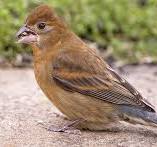
I saw a strange bird scratching below my feeder this week. It was a deep rich-brown color, larger than a sparrow but not as large as a thrasher and lacking long tail feathers. I had no clue until I scanned my bird guide. It was a female Blue Grosbeak. I saw her for two days, then no more. I have never seen a male Blue Grosbeak in my yard.
Adult males are royal blue with a tiny black mask in front of the eyes, with chestnut wing bars, and a black-and-silver beak. Females are primarily a cinnamon brown. The color is more intense on the head, paler on the underparts.
Blue Grosbeaks are unobtrusive despite their bright colors, although in summer males frequently sing their pleasant, warbling songs. Often, they sing while perched at high points in the shrubs and small trees of their generally open or shrubby habitats.
Blue Grosbeaks are characteristic species of old fields beginning to grow back into woodland. They breed in areas covered in a mix of grass and shrubs, with usually a few taller trees nearby. They are one of only a few birds that twitch their tails sideways.
I don’t know why this one female blue grosbeak chose my yard to visit, but she and her blue husband are welcome anytime.

